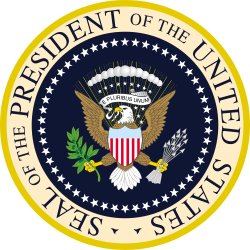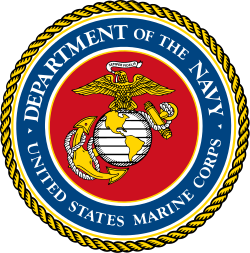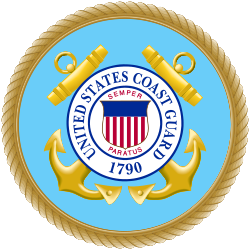Air Force One
| Den här artikeln behöver fler eller bättre källhänvisningar för att kunna verifieras. (2020-09) Åtgärda genom att lägga till pålitliga källor (gärna som fotnoter). Uppgifter utan källhänvisning kan ifrågasättas och tas bort utan att det behöver diskuteras på diskussionssidan. |

Air Force One ("Flygvapen Ett") är namnet, eller anropssignalen, på vilket flygplan som helst i det amerikanska flygvapnet som vid tillfället flyger USA:s president. I dagsläget finns det två mycket modifierade Boeing 747 som i folkmun kallas för Air Force One. Dessa plan innehåller allt som ett presidenthögkvarter kan förväntas innehålla. De ska även kunna motstå den elektromagnetiska puls som bildas i samband med en kärnvapenexplosion. Andrews Air Force Base utanför Washington, D.C. är Air Force Ones hembas. För kortare resor finns även mindre flygplansmodeller för presidenten att välja bland. Vid transatlantiska resor används vanligen båda dessa Boeing 747 VC-25. Vilket plan som då egentligen är Air Force One är det mycket få som vet. Vid president Barack Obamas landning på Kastrup 2 oktober 2009 ankom dock bara ett av dem (det märkt 29000). Flygplanen är snart 30 år gamla.
Det flygplan som USA:s vicepresident flyger med har anropssignalen Air Force Two ("Flygvapen Två").
Presidentiell transport
Det första flygplanet som användes för presidentresor var en så kallad flygbåt. Det användes för att transportera dåvarande presidenten Franklin D. Roosevelt till Casablancakonferensen i januari 1943. Det beslutades i och med hotet från tyska ubåtar att det var säkrare att flyga än att åka båt.
B-24 Liberator
Det första planet som officiellt fick namnet Air Force One som togs i bruk var en B-24 Liberator bombplan som byggdes om 1944. Det fick smeknamnet Guess Where Two (ordlek på "Gissa Varthän"). Det beslutades dock efter två olyckor med liknande plan att byta modell.
För att president Roosevelt lättare skulle kunna röra sig i planet byggde man om en C-54 Skymaster så den blev handikappanpassad med bland annat en hiss. Planet byggdes med syftet att presidenten skulle kunna övernatta i planet och dessutom styra landet från denna position. Därför fanns sovrum och radiotelefon på planet.[1] Detta plan fick smeknamnet Sacred Cow.
När vicepresidenten Harry S. Truman vid Roosevelts död 1945 blev president bytte han ut flygplanet mot en C-118 Liftmaster och döpte det Independence, möjligen som referens till sin födelseort, Independence i Missouri. Detta var det första presidentiella lufttransporten med specifik exteriör i form av en örn målad på nosen.
Air Force One
En incident 1953 där dåvarande presidenten Dwight D. Eisenhowers plan och ett annat plan med samma flightnummer (Air Force 8610) delade luftrum gav upphov till det unika namnet Air Force One - ett namn som därmed var fastslaget som tillägnat presidentens plan.
Eisenhower bytte sedan ut planen mot Lockheed Constellations döpta Columbine II och Columbine III efter hemmastaten Colorados delstatsblomma. Eisenhower moderniserade Air Force One genom att låta installera en telefon och teleprinter.
Mot slutet av Eisenhowers tid som president införde han det första jetplanet som Air Force One. Han gjorde en goodwillresa kallad "Flight to Peace" mellan den 3 och 22 december 1959 där han under denna tid besökte 11 asiatiska länder och avverkade 35 000 km. De byttes 1962 mot en modifierad (bland annat extra tankar) Boeing 707 som var i tjänst till 1998 och en likadan som var i tjänst 1972-2001.
Ett av flygplanen (SAM 26000) finns utställt på National Museum of the United States Air Force vid Wright-Patterson Air Force Base utanför Dayton, Ohio, det andra (SAM 27000) står på Ronald Reagan Presidential Library and Museum i Simi Valley, Kalifornien.
Två ombyggda 747-200B med beteckningen VC-25A levererades under president George H.W. Bush år 1990 (märkt 28000) resp 1991 (märkt 29000). Det är oftast ett av dessa plan som avses när man pratar om Air Force One.
National Airborne Operations Center
Hette tidigare National Emergency Airborne Command Post (NECAP).
NAOC, en Boeing E-4, är en flygande ledningscentral för USA:s högsta ledning. Används i huvudsak endast av USA:s försvarsminister.
Se även
Referenser
Noter
- ^ Världens historia nr9/2007 sid 11
Externa länkar
 Wikimedia Commons har media som rör Air Force One.
Wikimedia Commons har media som rör Air Force One.
| ||||||||
Media som används på denna webbplats
Författare/Upphovsman: Tkgd2007, Licens: CC BY-SA 3.0
A new incarnation of Image:Question_book-3.svg, which was uploaded by user AzaToth. This file is available on the English version of Wikipedia under the filename en:Image:Question book-new.svg
U.S. Department of The Army Emblem.
- In the center is a Roman cuirass below a vertical unsheathed sword, point up, the pommel resting on the neck opening of the cuirass and a Phrygian cap supported on the sword point, all between on the right an esponton and on the left a musket with fixed bayonet crossed in saltire behind the cuirass and passing under the sword guard.
- To the right of the cuirass and esponton is a flag of unidentified designs with cords and tassels, on a flagstaff with spearhead, above a cannon barrel, the muzzle end slanting upward behind the cuirass, in front of the drum, with two drumsticks and the fly end of the flag draped over the drumhead; below, but partly in front of the cannon barrel, is a pile of three cannon balls.
- To the left of the cuirass and musket is a national color of the Revolutionary War period, with cords and tassels, on a flagstaff with spearhead, similarly arranged above a mortar on a carriage, the mortar facing inward and in front of the lower portion of the color and obscuring the lower part of it; below the mortar are two bomb shells placed side by side.
- Centered above the Phrygian cap is a rattlesnake holding in its mouth a scroll inscribed "This We'll Defend."
- Centered below the cuirass are the Roman numerals "MDCCLXXVIII."
- For differences between this text description and the emblem shown above, see "Army Seal vs. Army Emblem", below.
Seal of USA:s flygvapendepartement - militärdepartement inom USA:s försvarsdepartement
Seal of the United States Marine Corps. It is defined in Executive Order 10538 (alternate source) as:
For more information, see here.Standing upon the western hemisphere of the terrestrial globe containing the lines of latitude and topographical outlines of North, Central, and South America, an American bald eagle with wings displayed horizontally and inverted holding in his beak a scroll inscribed with the motto SEMPER FIDELIS, all bronze. Behind the western hemisphere a foul anchor bend sinister-wise with stock, arms, and flukes in slight perspective, all bronze, on a scarlet background and within a dark blue band edged in gold circumscribed by a gold rope rim and inscribed DEPARTMENT OF THE NAVY • UNITED STATES MARINE CORPS in gold letters. The central device of the seal is the emblem of the United States Marine Corps.
United States Coast Guard Seal, in correct PMS colors. This emblem shall only be used in accordance with the Coast Guard Heraldry Manual, and is not to be reproduced commercially without prior approval of the U.S. Coast Guard.
Air Force One, the typical air transport of the President of the United States of America, flying over Mount Rushmore.
*Description: On a circular background of fair sky and moderate sea with land in sinister base, a tri-mast square rigged ship under way before a fair breeze with after top-sail furled, commission pennant atop the foremast, National Ensign atop the main, and the commodore's flag atop the mizzen. In front of the ship a luce-type anchor inclined slightly bendwise with the crown resting on the land and, in front of the shank and in back of the dexter fluke, an American bald eagle rising to sinister regarding to dexter, one foot on the ground, the other resting on the anchor near the shank; all in proper colors. The whole within a blue annulet bearing the inscription "Department of the Navy" at the top and "United States of America" at the bottom, separated on each side by a mullet and within a rim in the form of a rope; inscription, rope, mullet, and edges of annulet all gold. *Background: The policy for use of the Navy seal and emblem is contained in SECNAV Instr 5030.4 and SECNAV Instr 5030.6. The seal design was approved by the President of the United States by Executive Order 10736 dated October 23, 1957. Request for use of the Navy emblem should be submitted in writing to Defense Printing Service, ATTN: DPSMO, 8725 John Kingman Rd Suite 3239, Fort Belvoir, VA 22060-6220. The telephone number is (703) 767-4218. 1879 version here: http://etc.usf.edu/clipart/54900/54985/54985_seal_navy.htm







